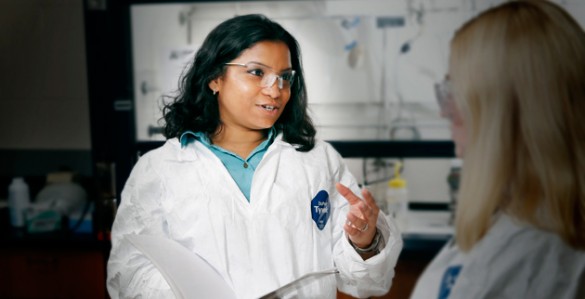Rizia Bardhan has a large picture of Mahatma Gandhi in her office.
“Gandhi has always been very special to me,” she said. “We share the same birthday. He exemplifies the power of perseverance.”
Perseverance has carried the new assistant professor of chemical and biomolecular engineering to Nashville from Kolkatta, India, where she was born.
Early in life, Bardhan was exposed to engineering principles through her father and several uncles who are engineers. She showed an aptitude for math and science as a child and won a national award in the 10th grade for the highest mathematics score on a national exam that all Indian students are required to take.
After deciding to get her university education in the United States, Bardhan enrolled at Westminster College, a small liberal arts university in Fulton, Mo. While getting a double degree in math and chemistry, she served as a resident adviser, president of the chemistry club, vice president of the mathematics society and vice president of the international club, all while tutoring students in math and chemistry. “I almost got a philosophy degree, but I just didn’t have enough time,” she said.
Bardhan went to Rice University for her doctorate so she could study with pioneering nanotechnologist Naomi Halas, whose research involves creating new nanoscale objects that interact with light and utilizing them for biomedical and electronics applications. “Halas really inspired me,” Bardhan said. “There are so few women in engineering, and she was a great role model.”
In her five years at Rice, Bardhan co-authored 21 scientific papers and received a patent on the use of nanoparticles for cancer imaging and therapy. She also met and married Cary Pint, a graduate student in applied physics. After getting their Ph.D.’s, they found positions in the Bay Area: Bardhan as a postdoctoral fellow at Lawrence Berkeley National Laboratory and Pint as a research scientist at Intel Corp.
At the national lab, Bardhan worked on energy storage and conversion and contributed to a breakthrough—the design of a nanoparticle composite that can rapidly and repeatedly absorb and release hydrogen at modest temperatures.
In 2011, her accomplishments led Forbes magazine to include her in its prestigious “30 under 30” list of rising stars in science. Pint also made the list for his research on high-energy batteries.
During her fellowship, the pair began searching for joint academic positions.
“We really liked Vanderbilt and Nashville, and Vandy made us the best offer,” she said—assistant professorships in chemical and biomolecular engineering for her and mechanical engineering for him—“so here we are.”
